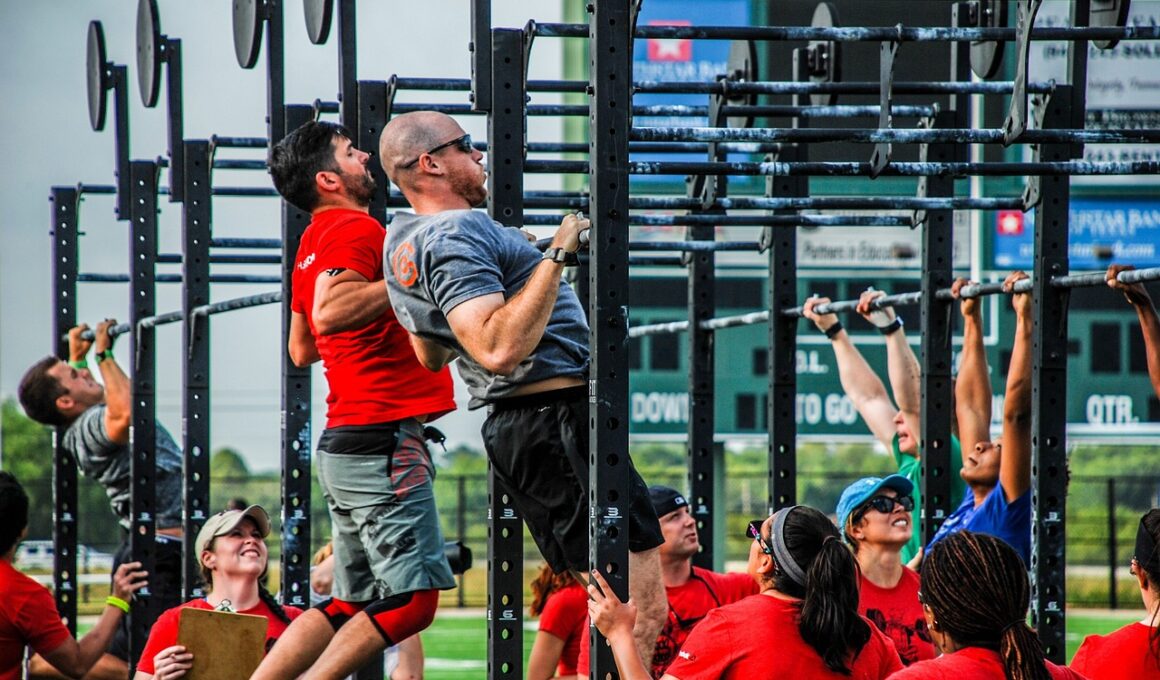Functional Core Stability Workouts for Crossfit Success
CrossFit is an intense fitness regime that demands athletes tap into their physical and mental limits. Core stability plays a critical role in improving athletic performance. Having a strong core ensures optimal power transfer between the upper and lower body. This results in enhanced movements during lifts, jumps, and other functional tasks. Implementing functional core training helps CrossFit athletes reduce injury risk. Integrated exercises that emphasize stability, like planks, bird-dogs, and medicine ball throws, develop the vital muscles in the core region. These exercises effectively activate not just the abs, but also the obliques, lower back, and pelvic floor. All these areas must be developed in tandem to ensure outstanding overall stability. Additionally, focus on compound movements will encourage recruitment of various muscle groups, improving overall body strength and coordination. A surprising fact is that many traditional core workouts lack the dynamic movements required in CrossFit. Therefore, incorporating functional exercises tailored to CrossFit needs will provide an edge in workouts and competitions. To achieve the best results, consistency is key in functional training, accompanied by proper nutrition and rest.
Understanding Core Stability
Core stability forms the foundation of strength in CrossFit. It essentially refers to the ability to control and stabilize the trunk while maintaining dynamic movements. The core comprises muscles located in the abdomen, back, and pelvis. These muscles form a complex web that supports the spine and aids in movement efficiency. Functions of a strong core extend beyond aesthetics; they include better posture, increased athletic performance, and reduced lower back pain. Also, poor core stability can lead to inefficient movements, ultimately impacting weightlifting and overall performance. Identifying core weakness is essential; athletes can do this by assessing their movement patterns. Common signs include pain during lifts and lack of power transfer. Enhancing core stability involves engaging different muscle groups, such as the transverse abdominis, erector spinae, and rectus abdominis. Exercises such as dead bugs, kettlebell carries, and stability ball exercises significantly boost performance. It’s vital to combine these movements with functional training that mimics real-life challenges. Incorporating dynamic and isometric exercises will contribute to improved stability and foundation strength necessary for successful CrossFit training.
Functional core stability workouts for CrossFit go beyond conventional abdominal exercises. Traditional movements like crunches may not sufficiently challenge the body’s core stabilizers. Instead, functional workouts use compound, multi-joint movements to engage core muscles more effectively. Some examples include overhead squats, kettlebell swings, and landmine presses. These exercises promote coordination and functional strength, which directly translates to better CrossFit performance. Additionally, incorporating instability through tools like BOSU balls or stability discs can add further challenge, necessitating greater core engagement. Think of integrating exercises such as renegade rows, where support from the core is imperative while performing other tasks. One of the greatest advantages of functional workouts is their adaptability; variations can be modified to accommodate different skill levels. Beginners can start with simpler static holds, gradually working towards dynamic movements as they progress. Furthermore, these workouts can be tailored to focus on specific skills and CrossFit goals. By selecting exercises that align with personal needs, athletes can maximize their results. Variety is crucial. Mixing in different workout styles, speeds, and intensities keeps training exciting and challenging, fostering continuous improvement in core stability and strength.
Essential Functional Exercises for Core Stability
Integrating essential functional exercises for core stability into a CrossFit routine can enhance overall performance. Begin with foundational movements, such as the plank. This exercise strengthens the entire core, promoting endurance and stability. The side plank is also valuable for targeting the obliques. Furthermore, consider integrating dynamic movements like Russian twists, which engage the entire trunk during rotation — crucial for many CrossFit movements. Another great exercise is the kettlebell Turkish get-up, which emphasizes stability and coordination. It challenges the core through various ranges of motion while also improving shoulder strength. For athletes looking to enhance power and functionality, add medicine ball slams — this explosive movement combines upper body strength with core engagement. Including exercises like woodchoppers will further strengthen core stability in rotational patterns. To execute these workouts effectively, pay attention to form and alignment to avoid injuries. Aim to incorporate three to five core-focused exercises into each training routine. Focusing on quality over quantity helps achieve better results. Consistency and dedication to core stability work will translate into improved performance in other CrossFit competitive areas.
During functional core stability workouts for CrossFit, it’s paramount to monitor progress effectively. Track the number of repetitions, duration of holds, and overall engagement during workouts for tangible results. Using fitness apps can offer insights into areas needing improvement. Moreover, prioritize combining functional core training with movements typical in CrossFit to enhance skill application. For instance, during the clean and jerk, apply core engagement strategies practiced in stability workouts. This translates well into competitive scenarios. Regularly seeking feedback from a coach can also help refine technique and intensity levels. Additionally, smart goal setting can keep motivation high. Goals can be specific, measurable, achievable, relevant, and time-bound (SMART), which fosters a clear path toward improvement. Celebrating small victories along the way supports a positive mindset. Finally, remember rest and recovery play a significant role in improving strength and stability. Allow muscles to recover adequately between workouts. Overtraining can lead to fatigue and decreased performance over time. Balance core workouts with full-body strengthening initiatives to maintain overall fitness levels while ensuring the core remains stable during intense CrossFit sessions.
Wrapping Up Core Training Insights
As CrossFit athletes, understanding the importance of functional core stability workouts is foundational for success. By prioritizing core strength through varied and dynamic exercises, athletes can effectively mitigate injury risks while improving performance in a multitude of CrossFit tasks. The holistic benefits extend beyond CrossFit; strong core stability supports everyday activities and enhances overall fitness. Moreover, awareness of common weaknesses and carefully designed programs tailored to individual needs allows for personalized improvements. Staying committed to a structured core training regimen ultimately yields good results. To maximize workout potential, incorporate innovative exercises that challenge the entire core region. Strive for consistency, monitor progress, and evaluate the success of workouts in relation to performance gains. Delve into different training modalities, exploring yoga, Pilates, or even martial arts, adding variety to core workouts. Ultimately, professional guidance can amplify results as coaches often provide game-changing tweaks to routines. Ensuring that workouts remain engaging and effective allows CrossFit enthusiasts to thrive. The journey towards achieving peak functional core stability is not only rewarding but also vital for continued growth as a CrossFit athlete.
This balanced approach to core stability exercises guarantees improved CrossFit performance over time. Athletes are reminded to blend these core workouts into their regular CrossFit routines. Not only does core training render immediate effects when performing Olympic lifts, but it also helps in functional movements such as burpees and box jumps. Consistently focused core workouts also promote greater recovery speed between intense training sessions. This adaptability signifies overall fitness is repeatedly enhanced as core strength accounts for a substantial part of physical exertion. Connecting with fellow athletes and sharing experiences forms community support, fostering motivation among peers. Thus, challenges become collective rather than isolated. Integrating accountability by involving training partners can spotlight improvements and provide encouragement. As you push forward in your CrossFit journey, remember that core stability is just one piece of the puzzle. Balance workouts that strengthen endurance, strength, and flexibility into the training plan. Ultimately, investing in functional core stability offers a pathway to enhanced athleticism across all aspects of fitness. Start including these elements in your routine today for optimal results that lead to overall CrossFit success.


